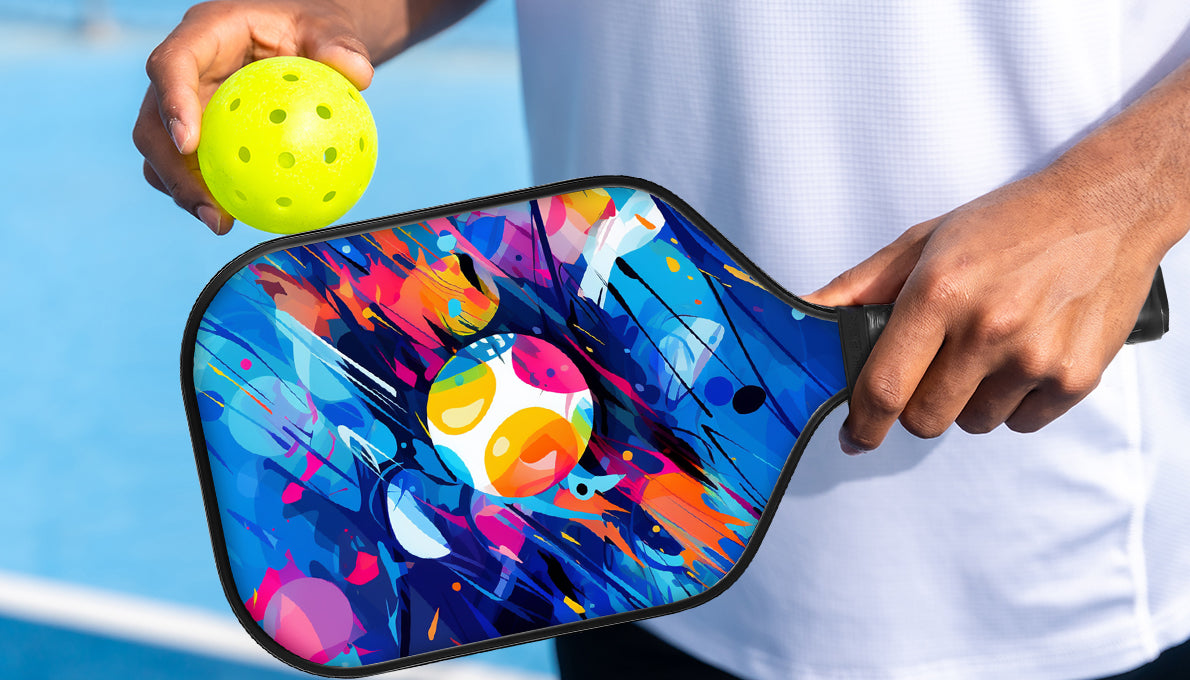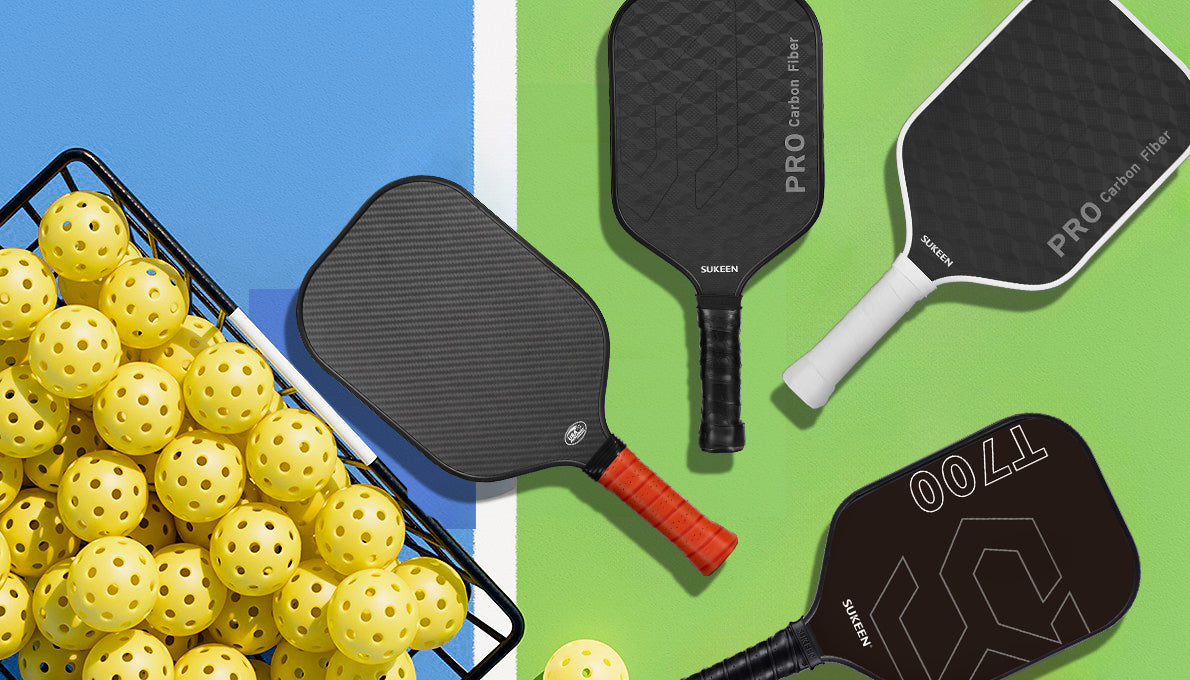What Should you Know about Changing your Pickleball Paddle?
Ⅰ. Why Replace Your Pickleball Paddle?Ⅱ. Intermediate and Advanced Players Frequently Change Rackets
Ⅲ. When to Replace Your Paddle
Ⅳ. Replacement Frequency
Ⅴ. How to Extend Paddle Lifespan
Ⅵ. Conclusion
Ⅰ. Why Replace Your Pickleball Paddle?
As a beginner, you might just be getting into pickleball and discovering the joy and challenges of this sport. Choosing the right paddle and replacing it at the right time is crucial for improving your skills and game experience.
1. Enhancing Skill Level
Better Control and Hitting Power
Beginners need a paddle that is easy to control and has moderate hitting power. As your skill level improves, your original paddle may no longer meet your needs. Upgrading to a better-performing paddle can help you control the ball's direction and power more accurately, improving your game performance.Check out "What to Look for in a Pickleball Paddle" to understand more about paddle features.
Adapting to Different Play Styles
During the initial stages, you might be exploring your play style. Changing paddles can help you try different types of equipment and find the paddle that suits you best, helping you develop your unique style.Learn more "Pickleball Paddle Single Player Game Tips".
2. Adaptability and Comfort
Enhancing Grip Comfort
Beginners often go through a period of adaptation, making the feel and comfort of the paddle grip very important. If you find that the grip does not fit your hand or feels uncomfortable, switching to an ergonomically designed paddle will significantly improve your game experience.For more tips, refer to "What Pickleball Paddle Weight Is Right for Me?"
Reducing Fatigue and Injury Risk
Beginners learning the basics might suffer from fatigue and injuries to the wrist, elbow, and shoulder due to an unsuitable paddle. Choosing a paddle with ergonomic design can effectively reduce sports injuries, making the learning process easier.
3. Improving Game Performance
Increasing Hitting Accuracy
A suitable paddle can significantly increase your hitting accuracy, making it easier to master basic skills. Upgrading to a better-performing paddle can give you an advantage in matches and rapidly improve your level.
Boosting Confidence
Switching to a better-performing paddle can make you more confident in matches, encouraging you to try new techniques and strategies, and quickly improve your game level.
Ⅱ. Intermediate and Advanced Players Frequently Change Rackets
Intermediate and advanced players need to replace their pickleball paddles more frequently to maintain their best condition. Here are the reasons:
1. Higher Game Intensity and Frequency
Frequent Training and Matches
Intermediate and advanced players usually train and compete several times a week, leading to higher usage frequency and intensity for paddles in a shorter time. Frequent use accelerates paddle wear, affecting its performance.
Strong Hits
Intermediate and advanced players have greater hitting power and speed, which puts more impact on the paddle, causing faster aging and damage to the paddle's materials and structure.
2. Performance and Technical Requirements
Precise Control and Hitting Power
Intermediate and advanced players have higher demands for paddle control and hitting power. Over time, the paddle's surface and edges wear out, affecting ball spin, speed, and control. Therefore, more frequent paddle replacement is needed to maintain high-level performance.For advice on paddles that offer great spin, read "Master the Secret of Spin Ball"
Need for New Technology
Intermediate and advanced players continuously seek to improve their skills, and new materials and technologies in paddles can offer better performance. Timely replacement of paddles ensures players are always using the most advanced equipment, maintaining a competitive edge.
3. Preventing Sports Injuries
Reducing Fatigue and Injury Risk
With increased training and match intensity, using a worn paddle can lead to fatigue and injuries to the wrist, elbow, and shoulder. New paddles usually offer better comfort and shock absorption, effectively reducing sports injuries. Choosing the right racket grip size can also help prevent injuries to a certain extent.You can refer to the article "What is the Grip Size for a Pickleball Paddle?"
Ⅲ. When to Replace Your Paddle
As an experienced pickleball player, I know the importance of a quality paddle for game performance. Despite many players having a strong attachment to their paddles, knowing when to replace them is key to maintaining your best condition on the court.
1. Visual and Physical Wear
Surface Wear and Cracks
Over time, the paddle surface will gradually wear out. You might notice scratches and cracks on the surface, which not only affect the appearance but also the hitting effect. Surface wear reduces friction, affecting ball spin and control. Cracks can lead to uneven energy transfer during hits, affecting hitting power. I remember once during an intense match, I suddenly noticed a significant crack on my paddle surface, which caused my hits to lose their usual power and control. After the match, I immediately replaced my paddle, restoring my previous level.
Edge Wear
The edges of the paddle also wear out during frequent use, reducing paddle stability and durability. Edge wear can cause uneven ball bounce during hits, affecting hit stability and accuracy. I once used a paddle with worn edges in a match, severely affecting my attack and defense stability.There are many types of edge protection for pickleball rackets. The edge protection design can also greatly extend the use time of the racket.There are many related introductions in "A Guide to Pickleball Paddle Edge Guard Types".
2. Reduced Hitting Effect
Decreased Hitting Power and Spin
When you notice your hits lack the previous power and spin, it might be a sign that the internal structure of the paddle is aging. During training, I once suddenly found my hits lacked speed and spin, although my technique and power remained unchanged. After inspection, I found that the honeycomb structure inside the paddle had started to age.
Loss of Control
If you find it hard to precisely control the ball's speed and direction, it could be due to the paddle surface material losing friction. Internal structure aging is not easy to detect by appearance but significantly impacts hitting effect, control, and durability.
3. Grip Wear
Loose or Deformed Grip
Grip wear is also an important signal. A loose or deformed grip affects your comfort and hit stability. During an intense match, I once found my grip starting to loosen, causing discomfort and affecting hit stability. After the match, I replaced the grip immediately and found that other parts of the paddle had worn out, so I replaced the entire paddle.
Surface Wear on Grip
When you notice the grip surface starting to wear out, affecting grip comfort, it is also a good time to replace the paddle. A few years ago, I noticed the grip felt slippery during matches, affecting my hitting power and control. After replacing the grip, the feel immediately improved.
4. Usage Time and Frequency
Aging After Frequent Use
The lifespan of a paddle is closely related to its usage frequency. If you train and compete several times a week, replacing the paddle every few months is necessary. From personal experience, replacing the paddle every six months can ensure I always stay in my best condition during matches.
Performance Decline After Long-Term Use
Even with infrequent use, long-term storage can lead to paddle performance decline. I once had a paddle that, despite not being frequently used, showed a significant decline in hitting effect after a few years of storage. Replacing it with a new paddle immediately improved the hitting effect.
5. Advances in Materials and Technology
New Materials and Technologies
With technological advances, new materials and technologies are continuously introduced. For example, carbon fiber materials are lightweight, strong, and highly durable, making them perfect for intermediate and advanced players. After switching to SUKEEN's carbon fiber paddle a few years ago, I noticed a significant improvement in hitting power and control.At present, my favorite racket is still a carbon fiber racket, "What is the best material for a pickleball paddle?" thinks so too!
Ⅳ. Replacement Frequency
1. Beginner Players
Suggested Replacement Frequency: 6-12 Months
Focus on Basics During Learning Period
Beginners focus on mastering basic skills during the learning period, so paddle wear is relatively low. Thus, replacing every 6-12 months is sufficient.Beginners do not need to frequently replace high-end paddles; entry-level paddles with good value are suitable.
Attention to Wear Signals
When the paddle surface shows noticeable scratches or wear, which can affect hitting accuracy, consider replacing it. Worn or uncomfortable grips can also affect holding comfort, so consider replacing the grip or paddle.
2. Intermediate Players
Suggested Replacement Frequency: 3-6 Months
Improving Skill Level
Intermediate players who train and compete more frequently should replace their paddles every 3-6 months to maintain optimal condition.Intermediate players need better-performing paddles to improve hitting effect and control, so mid-to-high-end paddles are recommended.
Monitor Wear Conditions
When the paddle surface friction decreases, affecting spin, consider replacing it.If the internal structure feels aged and hitting effect declines, replace the paddle promptly.
3. Advanced Players
Suggested Replacement Frequency: 1-3 Months
Maintaining Peak Condition
Advanced players in high-intensity training and matches should replace their paddles every 1-3 months to stay at their peak. Advanced players need top-performing paddles to maximize their skill levels, so high-end paddles like SUKEEN's carbon fiber series are recommended.
When hitting stability declines and the paddle cannot provide consistent hitting effect, replace it immediately.High-intensity use can cause structural damage; regularly check and replace as needed.
Ⅴ. How to Extend Paddle Lifespan
Proper maintenance and usage techniques can significantly extend the paddle's lifespan, reducing the frequency of replacements.
1. Proper Storage Methods
a). Avoid Extreme Temperatures
High-Temperature Environments
Do not expose the paddle to high temperatures for long periods, such as in a sunlit car or outdoor heat. High temperatures can cause material aging, reducing the paddle's strength.
Low-Temperature Environments
Avoid storing the paddle in low-temperature environments, as cold can make the material brittle, increasing the risk of breakage.
b). Dry Environment
Moisture Protection
Keep the paddle dry when storing it, avoiding damp environments. Moisture can damage the paddle material, especially wooden or composite paddles.
c). Use Protective Covers
Protective Covers
Use paddle covers to store your paddle, effectively preventing scratches, bumps, and external damage, and prolonging its lifespan.
2. Correct Cleaning and Maintenance
a). Regular Cleaning
Surface Cleaning
Regularly clean the paddle surface using a soft cloth and mild detergent. Avoid using strong cleaners to prevent surface damage. Proper cleaning can maintain paddle friction and hitting effect.
b). Replacing Worn Parts
Grip Replacement
Regularly check the grip for wear and replace it in time to maintain grip comfort and hitting stability. I found that replacing the grip every three months kept my paddle in the best condition.
3. Avoid Excessive Use
a). Reasonable Usage Frequency
Balanced Training and Rest
Balance training and rest to avoid overuse of the paddle, which can lead to fast aging and damage. After intense training, giving the paddle time to rest can prolong its lifespan.
b). Preventing Severe Collisions
Avoiding Ground Impact
Avoid hard collisions with the ground or other hard objects during use, as this can cause cracks and damage to the paddle surface and internal structure.For more information about cleaning your racket, click "How to clean and maintain pickleball paddle?".

Ⅵ. Conclusion
Understanding the importance of replacing pickleball paddles and when to do so is crucial for both beginners and experienced players. Regular inspection and timely replacement of your paddle can help maintain your best condition, improve your game performance, and prolong the paddle's lifespan. Proper maintenance and usage techniques can also reduce the frequency of replacements, saving costs and maximizing the paddle's lifespan. You can also choose a racket made using thermoforming technology, click "The Secret of the Thermoformed Pickleball Paddle".
As an experienced pickleball player, I deeply understand the importance of paddle replacement. Using a well-maintained, high-performance paddle can enhance your hitting effect, control, and comfort, allowing you to excel on the court. Whether you are a beginner or an advanced player, timely paddle replacement is essential for your progress and success in pickleball.
Related Articles
Pickleball Paddle Choice Between Different ThicknessesWhat is a Delaminated Pickleball Paddle?
How to Judge Whether a Pickleball Paddle is Good or Bad?
Why Does Everyone Fall in Love with Pickleball?
Pickleball Doubles Strategy Guide






